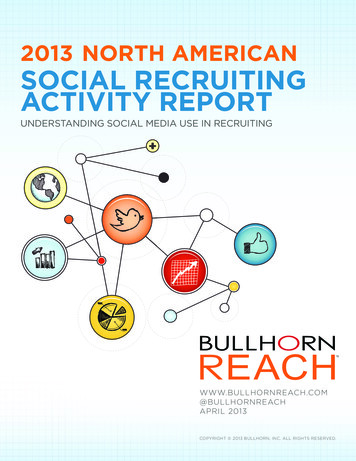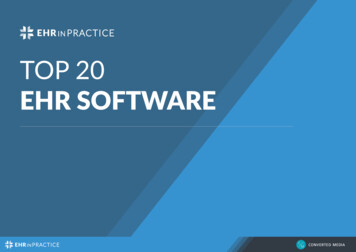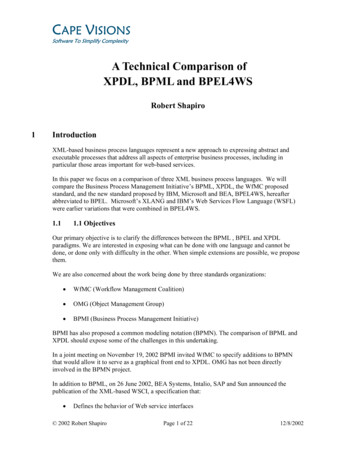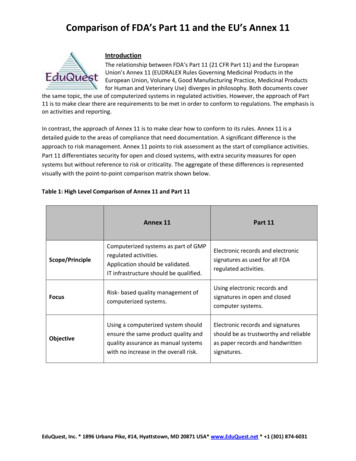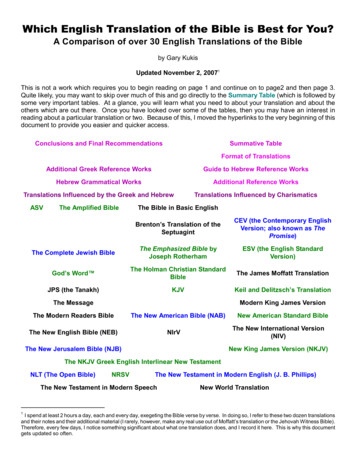
Transcription
Which English Translation of the Bible is Best for You?A Comparison of over 30 English Translations of the Bibleby Gary KukisUpdated November 2, 20071This is not a work which requires you to begin reading on page 1 and continue on to page2 and then page 3.Quite likely, you may want to skip over much of this and go directly to the Summary Table (which is followed bysome very important tables. At a glance, you will learn what you need to about your translation and about theothers which are out there. Once you have looked over some of the tables, then you may have an interest inreading about a particular translation or two. Because of this, I moved the hyperlinks to the very beginning of thisdocument to provide you easier and quicker access.Conclusions and Final RecommendationsSummative TableFormat of TranslationsAdditional Greek Reference WorksGuide to Hebrew Reference WorksHebrew Grammatical WorksAdditional Reference WorksTranslations Influenced by the Greek and HebrewTranslations Influenced by CharismaticsASVThe Amplified BibleThe Bible in Basic EnglishBrenton’s Translation of theSeptuagintCEV (the Contemporary EnglishVersion; also known as ThePromise)The Complete Jewish BibleThe Emphasized Bible byJoseph RotherhamESV (the English StandardVersion)God’s Word The Holman Christian StandardBibleThe James Moffatt TranslationJPS (the Tanakh)KJVKeil and Delitzsch’s TranslationThe MessageModern King James VersionThe Modern Readers BibleThe New American Bible (NAB)The New English Bible (NEB)New American Standard BibleThe New International Version(NIV)NIrVThe New Jerusalem Bible (NJB)New King James Version (NKJV)The NKJV Greek English Interlinear New TestamentNLT (The Open Bible)NRSVThe New Testament in Modern English (J. B. Phillips)The New Testament in Modern Speech1New World TranslationI spend at least 2 hours a day, each and every day, exegeting the Bible verse by verse. In doing so, I refer to these two dozen translationsand their notes and their additional material (I rarely, however, make any real use out of Moffatt’s translation or the Jehovah Witness Bible).Therefore, every few days, I notice something significant about what one translation does, and I record it here. This is why this documentgets updated so often.
Owen’s Analytical Key to the Old TestamentThe SeptuagintREBThe Twentieth Century NTTEV (the Good News Bible)TNIVWilliam’s Translation of the New TestamentYoung’s Literal TranslationWorld English Bible (WEB)Significant PassagesConclusions and Final RecommendationsSummative TableRSVSoftwareGlossaryAppendixreface: This is an examination of the many translations of the Bible into English. As you read through this,I think you are going to be rather surprised. Generally those interested in which translation of Scripture isbest are often conservative, fundamental, evangelical Christians. You will be surprised to know that one ofthe more modern translations, which has very conservative, evangelical leanings, is also one of the mostinaccurate translations available. You may be surprised to know that one translation which is both in modernEnglish and yet remains quite faithful to the original text is a translation that you very likely have never even seen.You will be surprised to note that the version which has the best footnotes dealing with textual criticism is a versionthat you have never heard of before (Rotherham’s Emphasized Bible). The most literal English translation is alsoa version that you have never heard of before (Young’s Literal Translation). You will be surprised to know thatone of the very best of the modern translations (of the Old Testament) was not made by a Christian or a groupof Christians, but was translated by the Jewish Publication Society. One of the surprising weaknesses of mosttranslations is a serious lack of consistency (consistency is the quality of rendering the same Greek (or Hebrew)word with the same English word time and time again). However, there is one very consistent translation availableto you, and yet, you probably have never heard of it (again, Young’s Literal Translation).PWhat is the best English translation of Scripture? When I began this study, I already knew the answer to this; bythe time I finished, I changed my mind—several times. In fact, I came to conclusions that surprised me (and I’vestudied the Bible for several decades).Selecting the right Bible (or Bibles) is one of the most important decisions that you will make, yet few give thisdecision much thought. You might use the Bible that has been laying around your house unread for severaldecades; you might use the Bible your church uses, or you simply pick up a pulpit copy. Maybe a Christian friendsuggested this translation or that. At best, you may glance through a quarter page comparison between a dozenchoices, and select a translation based upon that. One thing which will surprise you, when you read this book,is that the best translation for Timothy is not necessarily the best translation for Paul.What you will find out when you read this book is that there are more issues at stake then you first realized; Iexpect that you will change your mind once or twice, even though friends of your might not use the word openminded when they describe you.If you do not want to wade through a lot of reading, then your are welcome to go immediately to the SummativeTable, which is found directly below.I have given you a lot to wade through. You may find all the information that you seek in the table below. Onceyou get the quick and dirty information that you seek, then you may return to the individual examinations of thevarious translations for more information.Summative TableCut to the Chase.Page -2-Format of Translations
Additional Hebrew ReferenceWorksAdditional Greek ReferenceWorksGuide to Recommended Hebrew ReferenceWorksAdditional Reference WorksHebrew Grammatical WorksSummative TableVery literal, almost word-for-wordtranslations, designed for seriousand careful study:ESV, KJV, NKJV, NASB, Young’s Literal Translation, TheEmphasized Bible, The Amplified Bible.The best Biblepreference):NKJV with Scofield Notes; NKJV with NIV notes; NASB with ScofieldNotes; NASB with NIV notes. I don’t know if some of these even exist,but if I was to do it all over again, these would have been my choices formy primary Bible.The translationliterature:(inisorderalsoofgoodKJV, NKJV, ESV, REB and the Tanakh. One of the reasons that theKJV stood for so many years is, it was an accurate translation, but it wasa powerful and literal rendering as well. O, that even Shakespear couldthis well write!Other sources for very literaltranslations:Keil and Delitzsch, in their commentary on the Old Testament, offer atranslation as they exegete any given passage. Apart from being in OldEnglish, the translation is generally very good. Barnes occasionally hasa passage or two translated out—however, this is not throughout hiscommentary. Kenneth Wuest has a four volume set of commentaries onmuch of the New Testament, and included is a very literal rendering ofmost of the books of the New Testament. Finally, I have a book calledThe NKJV Greek English Interlinear New Testament and it has aninterlinear word-by-word rendering of the New Testament, along with aslightly more free translation. The NKJV is printed along the side of theGreek in a different column.Reasonably literal, orthodox, butrelatively easy-to-read Bibletranslations:NASB, NKJV, ESV and The Amplified Bible.Literate, accurate and relativelyeasy-to-read Old Testamenttranslation (this is a bettertranslation, in many ways, than, forinstance, the CEV, NLT, REB):Tanakh (JPS).Modern English translation which isboth easy to follow and yetreasonably accurate:God’s Word , NIV, The Amplified Bible.Reasonably accurate, thought-forthought translationsGod’s Word , REB, NEB, NAB, NJB, NIV. All of these translationshave their own weaknesses.Best reading Bible (either forreading to yourself or for readingaloud):NLT, JPS (Tanakh), CEV, the Message, NAB, NJB.Page -3-
Summative TableModern English translation with aconservative bias:NASB, NKJV, ESV, CEV, God’s Word .Very easy to read, easy tounderstand translations:NLT, TEV, CEV.Most pleasantly formatted or laidout:CEV, NLT. The Open Bible (the NLT) has the most extras, which arealso pleasantly laid out. However, in both cases, the quality of the extrasis at times questionable.Modern English translations whichstray significantly from the originaltext (we might call these the moreimaginative texts):CEV, NLT, TEV. Note that, even though the CEV has a very conservativebias, it is not very close to the original.Modern English translation with afairly theologically liberal bias:NEB, The Living Bible, Moffatt’s Translation.Traditional Jewish order for the OldTestament:The Complete Jewish Bible; the Tanakh.Bibles in chronological order:The Reese Chronological Bible (KJV); The Narrated Bible (NIV). On theplus side for Reese, there are dates on almost every page. On thenegative side, these dates are, in some cases, way off. Also, I don’t knowthat I agree with its sequencing of the narratives. The Narrated Bibleseems to flow, whereas Reese’s Chronological Bible seems to be morechoppy; however, one very nice feature of Reese’s Bible is that thehistory of Israel and Judah are laid side-by-side, one occupying onecolumn, the other occupying the other. In the Narrated Bible, Judah iscovered for awhile, and then Israel, and then Judah again. For intensivestudy purposes, there is no clear favorite. For light studying, either wouldwork. If you need dates, then Reese’s is for you. If you simply want toread the Bible through chronologically, then the Narrated Bible is the bestchoice.Strongly recommended:The Amplified Bible, God’s Word , ESV, KJV, NASB, NKJV, NRSV,Young’s Literal Translation, Rotherham’s Emphasized Bible.Recommended as a second Bible:Any of those directly above, as well as NIV, REB, NEB, NJB, NAB, NLT.Recommended if your readingskills are particularly weak or if yourEnglish is poor:TEV, NLT, CEV.Translations with part of all of theApocrypha—not every printing ofthese translations will have theApocrypha included (one of myNRSV’s has it; and two do not).The NRSV, the REB, the NAB and the NJB.The translation with the greatestnumber of footnotes on variantreadings (however, these predatethe Dead Sea Scrolls):Rotherham’s Emphasized Bible.Page -4-
Summative TableThe two translations which appearto make the most use of the DeadSea Scrolls.NRSV and NAB.Translations which tend to followthe Septuagint as often as not:Rotherham’s The Emphasized Bible, the NRSV, the REB, the NAB andthe NJB. The TEV also tends to follow the Septuagint (but not as oftenas the others mentioned).Translations which tend to tend tofollow the Massoretic text almostexclusively:The Complete Jewish Bible, the Tanakh, God’s Word , the KJV, theNKJV, the NASB, the NIV and Young’s Translation.Carry the imprimatur, whichindicates that this translation isacceptable to the Catholic Church.Catholic Church scholars wereinvolved in the translation andsponsorship of the REB.NRSV, NAB, NJB.Influenced by charismatics.NAB, NJB, NRSV, REB, RSV, TEV.Updated or supplanted versions:ASV, KJV, NEB, RSV, The Living Bible.Successors to above:NASB, NKJV, REB, NRSV, NLT (or, The Open Bible).Best footnote content:Scofield’s KJV, NIV Study BibleBest formatting of footnotes:NLT, NIV Study BibleWorst formatting for footnotesNRSVVery good information on LXX andDead Sea Scrolls in footnotesNRSVExcellent information on the LXXand Dead Sea Scrolls in footnotesnoneExcellent information on LXX,Vulgate, and other ancient versionsin footnotesRotherham’s The Emphasized BibleAlmost a total lack of footnotesGod’s Word , Complete Jewish Bible, NAB, NJB, Young’s LiteralTranslationNot recommended at all for anyreason:Moffatt’s Translation, the New World Translation (the self-servingJehovah Witness Bible translation).Cut to the Chase.Page -5-
Summative TableMy Recommendations:For a first Bible, I would suggest either the NASB or the NKJV (if eitherone is available with Scofield notes, then it comes with an even higherrecommendation). The ESV is also an excellent Bible, and free on theinternet. I believe that everyone should own at least one accuraterendering of Scripture. As a second Bible, I would strongly recommendthe NIV Study Bible. Finally, for a third version, I would recommendeither God’s Word or The Open Bible (the NLT). If your reading levelis low, then I strongly recommend the TEV (also known as the GoodNews Bible. If you do much by way of personal Bible study, you needScofield’s Notes.Format of TranslationsPoetry is distinguished from prose.CEV, The Complete Jewish Bible, God’s Word , the James MoffattTranslation, NAB, NASB (barely), NJB, NRSV, The Open Bible (NLT),REB, Rotherham’s Emphasized Bible, TEV, Young’s Literal Translation(again, barely).Written in true paragraph form.CEV, The Complete Jewish Bible (barely), God’s Word , NAB, NJB,NIV (barely), NRSV, The Open Bible (NLT), REB, TEV, Young’s LiteralTranslation (barely).Written strictly verse by verse. Eachnew verse is formatted as a newparagraph.The Amplified Bible (I have an old version from the 1960's), NASB,NKJV, KJV (wherein, the poetry is not generally distinguishable fromprose—it depends a lot upon who packaged the KJV).Verse numbering is unobtrusive.The Complete Jewish Bible, CEV, NAB, NIV, NJB, NLT, NRSV, REB,TEV.Verses are written on along the siderather than interspersing them asthe divisions occur.The Complete Jewish Bible (in the poetry sections only), the JamesMoffatt Translation, NEB, NKJV (in the poetry sections only), NRSV (inthe poetry sections only).Words not found in the originalmanuscripts but added to help withthe understanding of the verse aredistinguished.God’s Word , KJV, NASB, NKJV, Young’s Literal Translation.Two verses are occasionallycombined so that a betterunderstanding of the passage canbe achieved (that is, you cannotdetermine where one verse endsand the other begins).CEV, the James Moffatt Translation, The Open Bible (NLT), TEV (veryoccasionally).Verse order is changed with theintention of providing an easier tounderstand translation.CEV, the James Moffatt Translation.In my opinion, poetry should look like poetry and prose should look like prose. Even the proverbs should lookdifferent from poetry or prose. Prose should have groups of verses placed together in paragraph form. Thereis no distinguishing of verses in the original languages, so the idea of combining two or more verses is not abad idea. The less obtrusive the verse numbering is, the better.Page -6-
Additional Hebrew Reference WorksInterlinear Hebrew-English BiblesOwens’ Analytical Key to the Old Testament (it is outstanding as alanguage aide); the reference numbers refer to the Brown DriverBriggs Lexicon (which itself is a must for anyone who delves into theHebrew of any Old Testament passage). English translation with it isonly fair to good. Zodhiates’ The Complete Word Study OldTestament is also a good interlinear for the Old Testament, with morehelps in the back of the Bible (however, the parsing consists ofconsiderably less information than Owen’s work and the referencenumbers are Strong’s).Hebrew ConcordancesYou must own The Englishman’s Hebrew Concordance of the OldTestament if you have any interest in the exegesis of the Old Testamentand understanding of the use of the Hebrew words.Hebrew LexiconsBrown Driver Briggs Hebrew and English Lexicon is given as thestandard. However, Gesenius’ Hebrew-Chaldee Lexicon to the OldTestament is invaluable; you should have them both, as Gesenius isbetter organized and, in my opinion, offers better English equivalents.For instance, þîyrâh (ä øÈ é è. ) [pronounced tee-RAW], is said to mean wall,fence, enclosure in Gesenius; in BDB, its meanings are given asencampment, battlement. Strong’s #2918 BDB #377. The former setof meanings is much more accurate. If you rely on Owens AnalyticalKey to the Old Testament, then you will need BDB, as it is keyed toBDB. Now, Strong’s Concordance has Greek and Hebrew Lexiconsin back, which are adequate for new believers, and Zodhiates’ CompleteWord Study Old Testament has an incomplete, but fairly good lexiconin the back (and it also has Strong’s Concordance in back as well). Ofthese, only Strong’s offers the pronunciation of the words (TheEnglishman’s Hebrew Concordance also offers pronunciations).Additional Greek Reference WorksInterlinear Greek-English BiblesZodhiates’ The Complete Word Study New Testament and The NKJVGreek English Interlinear New Testament are both very good works.Zodhiates has the KJV and above the words are Strong’s numbers alongwith a limited morphology (the gender, number and person are notgiven); the Greek text is off to the side. The latter work has the NKJV offto the side, with the Greek text in the middle of their Bible. Below theGreek text is a literal and then a slightly less literal rendering. There isnothing by way of Strong’s numbers or morphology. Quite frankly, Ihave not found anything for the New Testament as good as Owen’sAnalytical Key to the Old Testament (which is, by the way, keyed onlyto BDB numbers and not to Strong’s numbers).Greek Bible Reference workThe Analytical Greek New Testament. This does not have an Englishtext, but it has a complete morphology of each Greek word. No Strong’snumbers, unfortunately. You might call this a grammatical interlinear.Greek ConcordancesFor work in the Greek, you must own The Englishman’s GreekConcordance of the New Testament. For the beginner, Zodhiates’sComplete Word Study New Testament is an interlinear with areasonable Greek concordance.Page -7-
Additional Greek Reference WorksGreek LexiconsExegetical Dictionary of the New Testament (3 volumes); Arndt andGingrich’s Greek-English Lexicon; Zodhiates’s Word Study DictionaryNew Testament; Thayer’s Greek-English Lexicon;Additional Reference Works2Commentaries: Barnes NotesBarnes Notes are somewhat uneven—some books are given great,exegetical examinations, and others receive far less attention.Nevertheless, this is one of the least expensive and most insightful setof commentaries available. Barnes Notes are tremendous, readable,scholarly and literate. Barnes Notes is also available with e-sword.Commentaries: Thru the BibleRadioJ. Vernon McGee’s Thru the Bible Radio commentary (it’s availableas individual books, as a book or on at least two different CD’s, and itcan be downloaded from his website as well). McGee is not even a tenthas detailed as Barnes. However, McGee covers almost every majordoctrine there is in language that anyone can understand. His overviewsand illustrative material, which often seems too simple, belie histheological brilliance. You will get a very good, general understandingof any chapter of Scripture from examining McGee’s work; and you willchance upon almost every major theological doctrine, sometimes withoutrealizing it.C o m m e n ta r i e s : K e i l a n dDelitzsch’s Commentary on theOld TestamentAlthough I quote from Keil and Delitzsch’s Commentary on the OldTestament, their writing is dense, sometimes difficult to follow, and itpresupposes a working knowledge of several languages. Let me giveyou an example; this is a quote from Keil and Delitzsch: Just as óàsignifies imo vero (58:3) when it comes after an antecedent clause thatis expressly or virtually a negative, it may mean “nevertheless, Óìùò,”when it opposes a contrastive to an affirmative assertion, as is veryfrequently the case with í x or í â å.2 Did that make sense to you? This-csentence illustrates what I mean bythe descriptor dense. And you mayhave noticed that in one sentence, apart from English, we had threeother languages bandied about. Keil and Delitzsch are generally veryaccurate, they provide a great many insights, and even though I don’tquote from them extensively, I often use the information that theypresent. What tends to happen when I study their work in associationwith a personal exegetical study is that they will, more than any othercommentary, cause me to go back and revise or better explain what Ihave already written. They push me to be more precise in my handlingof Scripture. One sentence from them might cause me to go back intomy exegesis and add a two-page table to more carefully cover aparticular topic. If you are not involved in careful exegetical study, thenthis commentary would just gather dust on your shelf. However, if youexegete Scripture, and you recognize the importance of the originallanguages, then this might be the commentary is for you.Keil & Delitzsch’s Commentary on the Old Testament; 1966 Hendrickson Publishers, Inc.; Vol. 5, p. 321.Page -8-
Additional Reference WorksHorrible Commentaries:Lest you think that I simply named the commentaries which I have as thebest that is out there, think again. The ITC series, from what I have readso far (1 & 2 Samuel) is horrid. Gnana Robinson, the author of thisparticular booklet, at the very beginning superimposes 20th centuryvalues and rhetoric on his examination of the Scripture. His suppositionin chapter one causes him to completely misinterpret the portion of thesacrifice that was given to Hannah. He makes a host of theologicalerrors (such as saying that the Bible allows for a heathen to worship Godin their own way)3 as well as factual errors (Robinson mixes up his Bethshemesh’s in passages where it is clear that the cities referred to are indifferent tribal areas).4Weak Commentaries:Gordon’s commentary on I & I1Samuel, although not nearly as bad asRobinson’s, is simply unremarkable. Gordon has an extensivevocabulary, which makes reading his commentary enjoyable.Unfortunately, the read does not yield much fruit. The additional notesfound in the NIV Study Bible and Scofield’s Bibles are far superior toanything found in either of these two commentaries.Old Testament HistoryI wasn’t certain how to classify Edersheim’s Bible History Old Testament,but I had to mention it. Edersheim writes, very eloquently might I add,a history, in his own words, of the Old Testament, including such detailsas we might miss in our reading of Scripture. You may think, why notjust read the Old Testament? Here’s why: (1) Edersheim is a veryenjoyable read. If your mother or father ever put you to bed by recallinga Bible story from memory, this is what Edersheim does, with the addedbonus that he has a marvelous way with words. (2) There have beenseveral instances where, in my study of an Old Testament passage, thatI really did not get the gist of what was happening. For instance, in thebattle between the 20 Philistines and Jonathan with his armorbearer, Idid not understand the description of 1Sam. 14:14, nor did I correctlypicture the fight which ensued. I pictured this movie version withJonathan and his armorbearer maybe back-to-back, fighting twenty men,like, say, Buffy and one of her slayerettes against a pack of demons.However, this is not the picture painted by Scripture, but I could not seeit (and, in my defense, I had first gone through nearly 20 translations anda half-dozen commentaries, and still did not have the picture). Thenwhen I read what Edersheim wrote, the picture became quite clear.Let me add that, Edersheim’s work is different from the typicalcommentary, as he focuses more upon the narrative than the theology.This does not mean that he ignores theology; he just spends more timewith the story, which tends to convey the theology behind it.Bible Dictionaries:I tend to use J. D. Douglas’s The New Bible Dictionary the most often,although there is little about it that sticks out in my mind, apart from itbeing a very good one volume source.3Gnana Robinson, 1 & 2 Samuel; Let Us Be Like the Nations; International Theological Commentary; Eerdmans’s Publishing Co., GrandRapids, 1993; p. 36.4Gnana Robinson, 1 & 2 Samuel; Let Us Be Like the Nations; International Theological Commentary; Eerdmans’s Publishing Co., GrandRapids, 1993; p. 40.Page -9-
Additional Reference WorksBible Encyclopedia:My favorite is far and away The Zondervan Pictorial Encyclopedia of theBible. Because of the huge number of contributors, there will be timesthat it will contradict itself and many times that the material has a liberalbend.Manners and Customs ReferenceWorks:I have several, but Freeman’s is generally the best. It is arranged in theorder of the Bible, rather than topically (like Gower and Matthews).Miscellaneous Reference Works:Figures of Speech Used in the Bible by Bullinger. Although I have readcomments now and again which are negative concerning Bullinger, thisis an outstanding work and helps to clarify and classify various idiomsand figures of speech which are found in Scripture.Return to the Top of the PageSummative TableGuide to Recommended Hebrew Reference WorksNameBrown DriverBriggs Hebrew andEnglish LexiconGesenius’ HebrewChaldee Lexicon tothe Old TestamentTypeLexiconLexiconExtra FeaturesStrong PointsLimitationsBack index allowsyou to look up anyHebrew word if youh a v e St r o n g ’ snumber.Betterwordorganization thanStrong’s or Gesenius(e.g., cognates arelocated near eachother; homonyms arebetter distinguished).This is not equivalentto owning a GeseniusLexicon.Definitions aresometimes weak (thisis a translation of alexicon);thed e f i n i t i o n sthemselves are oftenpoorly organized.Word pronunciationnot given; not even apronunciation guide.English index (findthe English word inback, and you will begiven the pagenumber it occurson).Muchbetterdefinitions than BDB;the individual worddefinitions are betterorganized.Thewords themselves areplaced in orderessentiallybyStrong’s numbers.This is not equivalentto BDB above.Word pronunciationnot given; not even ag u i d et opronunciation.Cognates are oftens e p a r a t e d .Grammatical andanalytical index inback should havebeen included withthe individual words.Page -10-
Guide to Recommended Hebrew Reference WorksNameThe NewEnglishman’sHebrewConcordance of theOld TestamentOwens AnalyticalKey to the Extra FeaturesStrong PointsLimitationsHebrew to Englishand English toHebrew index inback. That is, lookup the English word,and all the Hebrewwords used totranslate it aregiven, along withtheir location in thisconcordance.Keyed to andorganized by Strong’snumbering system.Pronunciation foreach word given.Location of individualve r b s o r g a n ize dmorphologically (e.g.,all the Qal participlesof same verb aregrouped together). Aportion of each verseis given with eachlocation of everyword. The translatedword is italicized.It seems as thoughmy first version (ablue cover) had theBDB numbers aswell.It alsocontainedanappendix in backwhich contained theHebrewandChaldean names inback.The newversion does nothave either.Excellent morphologyof words given (forinstance, a verb maybe given to be theQal imperfect 3rdperson masculineplural; a noun isdenoted by number,gender and person).Words are keyed toBDB numbers. Textis covered practicallyone word at a time.Abbreviations aremuch easier tounderstand (you don’tneed a card tounderstand what’sup).Not keyed to Strong’snumbers. There areseveral mistakes.Diff ering Greektranslation could bebetter explained.Certainkeypre p os it i on s n o tdifferentiated (exceptin the Hebrew).There are severalmistakes throughout.By the fourth book,you could tell he ranout of steam, and wedo not have thevocabulary form ofthe verbs listed ineach and every case(in the Hebrew, this ishelful).It is what it is; it isthe best I havefound in that regard.It is organized by theMassoretic text.Page -11-
Guide to Recommended Hebrew Reference WorksNameStrong’sConcordanceWilson’s OldTestament WordStudiesZodhiates’s TheComplete WordStudy OldTestamentTypeExtra FeaturesStrong PointsLimitationsEnglishConcordanceVery basic Hebrewand Greek lexiconsin back ; eachword’s pronunciationis given along withtheEnglishtransliteration.There is also a basicpronunciation guideincluded. There is acomparative Englishc o n c orda nce inback, giving Englishwords that aresimilar.Strong’s numberaccompanies Englishword so you can tell ifan English word isused to translate one,two or ten differentHebrew or Greekwords. Even smallwords, like and, andtheir locations arelisted.Lexicons in back aretoo brief and primarilygive the Englishequivalents as foundin the KJV.A study of theOldTestamentwords fromthe EnglishThe English word isgiven and followedby the Hebrewwords used totranslate that word;the Old Testamentlocations are thengiven.You get a clue as tohow many differentHebrew words arehidden behind thesame English word.The other works citedmade this worksuperfluous for me.KJV OldTestamentwith HebrewhelpsGreat, yet brief,explanation of theHebrew grammar(e.g., just what is aQalinfinitiveabsolute?).Goodpronunciation guide.A good, albeitincomplete, HebrewLexicon in back.Strong’s Lexicon isalso found in back.Above each EnglishwordisthecorrespondingStrong’s number andt he m or pho l o g y.Footnotes on OT aresparse (less than oneper page), but good.The morphology isc o d e da n dincomplete (thenumber, gender andperson of verbs arenot given). Hebrewlexicon in back doesnot have the actualHebreworapronunciation of thewo r d ; o n l y t h eEnglish transliterationand Strong’s numberare given.Return to the Top of the PageSummative TablePage -12-
Hebrew Grammatical rewGrammar SyntaxExtra FeaturesGoodSecond year Hebrewgrammar referencebookThis is usually thelast book that Ireach for.E xt rem ely bas icbeginner’s textbookWhen I need abasic explanation, Igo to this grammarbook first.FairMansoor’sBiblical HebrewWeak PointsThis is the first orsecond grammarbook that I reachfor.GoodKelley’s BiblicalHebrewStrong PointsVery basic beginner’stextbookGoodSeow’s AGrammar forBiblical HebrewFirst orgrammarreach for.Beginner’s textbookwi t h i n t e r e s t i n gexcursionsReturn to the Top of the Pagesecondthat ISummative Tabl
Nov 02, 2007 · much of the New Testament, and included is a very literal rendering of most of the books of the New Testament. Finally, I have a book called The NKJV Greek English Interlinear New Testament and it has an interlinear word-by-word rendering of the New Testament, along with a slightly more fr



